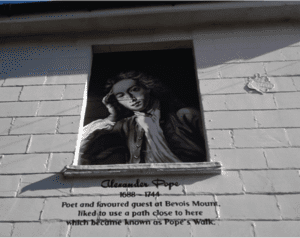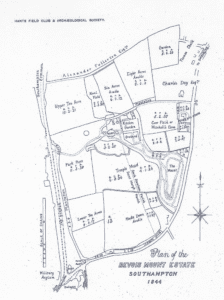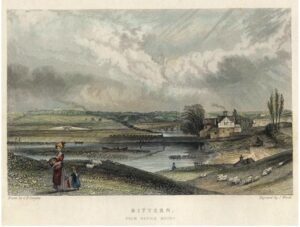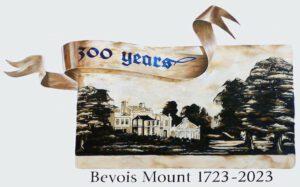When Charles Mordaunt, 3rd Earl of Peterborough came to Southampton in 1723 and decided to create his country estate on the outskirts of the walled town, it was undoubtedly the mound or mount that first caught his attention. He would have passed it on the main road into the town which in those days lay along Bevois Valley. We know that once the Padwell farmhouse had been converted into a suitable residence and he was able to welcome visitors, he would only take his guests to the summit of the mount when there was a high tide so that the view could be shown to its best advantage.

The poet, Alexander Pope, friend of the earl, became a frequent visitor to Bevois Mount. They shared an interest in landscape gardening and worked together on designing lawns, flowery dells, winding alleys, and statuary.

He described the view from the summerhouse that had been built on the summit: – ‘I write this from the most beautiful Top of a Hill I ever saw, a little house that overlooks the Sea, Southampton, and the Isle of Wight, where I study, write and have what leisure I please….’ Pope walked up the hill so regularly that the path he took became known as Pope’s Walk.

A later visitor described it similarly in The Sporting magazine of 1804: -‘And now the landscape opens with astonishing beauty. The spires of Southampton, the almost surrounding waters, the New Forest, terminated with the Isle of Wight, and a thousand moving objects, contribute to make the mind tranquillized beyond the ordinary course of human feeling.’
The importance of the mount to the earl is shown in this letter to a friend which he wrote when he was seventy-seven and in failing health: – ‘I want to make an appointment with you, Mr Pope, and a few friends more, to meet you upon the summit of my Bevis hill, and thence, after a speech and a tender farewell, I shall take my leap towards the clouds, to mix amongst the stars’.
So, what was this hill that aroused so much emotion? According to legend, Bevois Mount was either a burial mound containing the tomb of Southampton hero, Sir Bevois, or a fortification built by the Saxons under his command. According to some versions he fought against the Danes and according to others he fought against the Normans and was defeated by them ‘in the battell at Cardiff in Wales’
More mundane sources indicate that the Mount may predate both the Danes and the Saxons. John Speed in his History of Southampton tells of an oral tradition that Roman coins had been found on top of “Bevois Hill”. He goes on to say, “the side of the Hill next the Shoar is very steep and has a wet Ditch at the bottom of it”. He proposes that the hill may have been a scouting outpost for the Roman settlement at Clausentum. A description of the town in the Fletchers’ Street Directory surmises that there were two outposts, one being Northam and the other being Bevois Mount “at both of which places Roman coins have been found”.
In Characteristic Survivals of the Celts in Hants (1891), T.W. Shore proposes an even earlier origin: “The passage of the Itchen was strongly guarded by an earthwork strongly placed on a river cliff known as Rockdone, and later as Bevois Mount, destroyed since the beginning of this century”. The destruction referred to involved quarrying, which is mentioned below. The name Rockdone may later have been corrupted to Rockstone, the name of the lane which forms the south-western boundary of the estate.
There is a compelling argument that the prime purpose of the Mount was defensive, whenever it was built, because of the importance of the Itchen as a route to the hinterland and for the Romans to Venta (Winchester). The fact that this bend in the river was probably fordable at one time, makes it of even more strategic value.
The most conclusive evidence we have as to the size and shape of the mount is the Ordinance Survey map of 1846. The hill is still tree-clad and some of the paths created by the earl can still be seen. Although there are no contour lines, a close-up view reveals tiny white figures to the south-west showing that the ground rose steeply from 26 feet to 70 feet above sea level at this point.

It seems likely that an artificial mound was constructed on a spur of naturally high ground. As there are no figures given for the top of the mount, it would be safe to assume that it was flat at this time. The earl’s summer house apparently had not survived, as it is not shown. The number 26 is on the equivalent of Bevois Valley Road and increases in steps of five feet to the top where number 70 can be seen. The 70 would be roughly where the artist stood to paint Bittern from Bevois Mount by G.F. Sargent.

When the estate began to be sold off in the mid-19th century, the artificial mound, and the rock beneath it, were a source of building material and therefore remorselessly quarried to build the houses and roads that we have today. Unfortunately, so little of it now remains that the date and purpose of Bevois Mount will always be a mystery. In fact, many people today are unaware that the name Bevois Mount is based on the existence of a real hill. We hope that the publication of our booklet celebrating 300 years of Bevois Mount will help spread the word that this is an area, rich in history, that has remained intact since 1723 and the mount existed.

Oh, and if you want to know the location of the mount – simply stand with your back to Aldi, look across the road to the small parking area and then unleash your imagination so that the small bank of grass and trees behind it towers to a height of seventy foot above sea level and you can see the tiny figures of the earl and his friends on the summit.

Author: Alysson Hayes
Bio: Shortly after retiring as a teacher, Alysson became involved with Bevois Mount History. Drilling down into the heritage of a relatively small area has been interesting and satisfying for her, particularly as the group have ‘adopted’ Southampton Common. Bevois Mount History do guided walks and give talks. Alysson and her colleagues, Wendy Stokes have also written, A Walk around the Common and A Walk up the Avenue – available from October Books, Portswood, Southampton.

